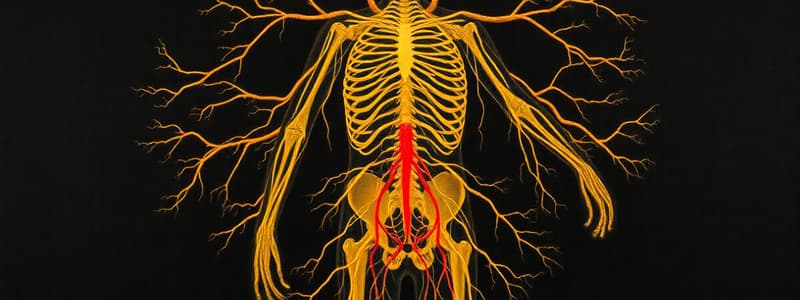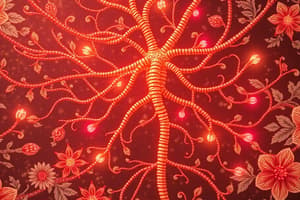Podcast
Questions and Answers
What is meant by reciprocal action in autonomic nervous system functionality?
What is meant by reciprocal action in autonomic nervous system functionality?
- Both systems work independently without any interaction.
- Both systems stimulate the same organ simultaneously.
- One system inhibits the other in the same effector organ. (correct)
- One system only is active while the other remains dormant.
Which action describes when the sympathetic and parasympathetic systems produce opposite actions on different effector tissues in the same organ?
Which action describes when the sympathetic and parasympathetic systems produce opposite actions on different effector tissues in the same organ?
- Single innervation
- Reciprocal action
- Complementary action
- Antagonistic action (correct)
In which situation do sympathetic and parasympathetic actions complete each other?
In which situation do sympathetic and parasympathetic actions complete each other?
- During sleep
- During digestion
- During exercise
- During grief (correct)
Which of the following is an example of the same action performed by both the sympathetic and parasympathetic systems?
Which of the following is an example of the same action performed by both the sympathetic and parasympathetic systems?
What is meant by single innervation in the context of the autonomic nervous system?
What is meant by single innervation in the context of the autonomic nervous system?
Which ganglia do the preganglionic sympathetic fibers synapse with postganglionic neurons?
Which ganglia do the preganglionic sympathetic fibers synapse with postganglionic neurons?
What is a primary function of the sympathetic nervous system during a fight or flight situation?
What is a primary function of the sympathetic nervous system during a fight or flight situation?
What effect does stimulation of the sympathetic nervous system have on the pupils?
What effect does stimulation of the sympathetic nervous system have on the pupils?
Which structure is NOT typically affected by postganglionic sympathetic neurons?
Which structure is NOT typically affected by postganglionic sympathetic neurons?
Which syndrome is characterized by miosis, ptosis, and anhidrosis on the same side of a cervical sympathetic nerve lesion?
Which syndrome is characterized by miosis, ptosis, and anhidrosis on the same side of a cervical sympathetic nerve lesion?
What is the primary function of the autonomic nervous system?
What is the primary function of the autonomic nervous system?
Where are the preganglionic neurons located in the autonomic nervous system pathway?
Where are the preganglionic neurons located in the autonomic nervous system pathway?
Which of the following accurately describes the structure of autonomic ganglia?
Which of the following accurately describes the structure of autonomic ganglia?
What characterizes the relay mechanism in autonomic ganglia?
What characterizes the relay mechanism in autonomic ganglia?
Which of the following represents a division of the autonomic nervous system based on origin?
Which of the following represents a division of the autonomic nervous system based on origin?
Flashcards
Autonomic Nervous System (ANS)
Autonomic Nervous System (ANS)
Part of the nervous system controlling involuntary actions (heart, smooth muscles, and glands).
Autonomic Ganglion
Autonomic Ganglion
Collection of nerve cells outside the CNS where preganglionic and postganglionic fibers connect.
Preganglionic Fiber
Preganglionic Fiber
Axon of the first neuron in the ANS pathway, originating in the CNS.
Postganglionic Fiber
Postganglionic Fiber
Signup and view all the flashcards
Sympathetic Nervous System
Sympathetic Nervous System
Signup and view all the flashcards
Reciprocal action (autonomic)
Reciprocal action (autonomic)
Signup and view all the flashcards
Antagonistic action (autonomic)
Antagonistic action (autonomic)
Signup and view all the flashcards
Complementary action (autonomic)
Complementary action (autonomic)
Signup and view all the flashcards
Same action (autonomic)
Same action (autonomic)
Signup and view all the flashcards
Single innervation (autonomic)
Single innervation (autonomic)
Signup and view all the flashcards
Sympathetic system origin
Sympathetic system origin
Signup and view all the flashcards
Sympathetic ganglia relay
Sympathetic ganglia relay
Signup and view all the flashcards
Sympathetic system function
Sympathetic system function
Signup and view all the flashcards
Horner's Syndrome cause
Horner's Syndrome cause
Signup and view all the flashcards
Horner's Syndrome symptoms
Horner's Syndrome symptoms
Signup and view all the flashcards
Study Notes
Autonomic Nervous System
- The autonomic nervous system (ANS) controls involuntary actions, such as cardiac muscle, smooth muscle, and glands.
- It occupies both the central nervous system (CNS) and the peripheral nervous system (PNS).
- The ANS pathway from the CNS to an effector organ consists of two neurons, except for the adrenal medulla.
- The first neuron is located in the CNS; its axon is called the preganglionic fiber.
- The first neuron synapses with the second neuron in an autonomic ganglion.
- The second neuron's axon, called the postganglionic fiber, innervates the effector organ.
Anatomical Divisions of ANS
- Cranial: originates from cranial nerve nuclei (III, VII, IX, X)
- Thoracic-lumbar: originates from the lateral horn cells of the thoracic and upper lumbar segments.
- Sacral: originates from the lateral horn cells of the sacral segments.
Physiological Divisions of ANS
- Sympathetic system: thoracolumbar
- Parasympathetic system: craniosacral
Autonomic Ganglia
- Definition: collections of nerve cells outside the CNS, where preganglionic fibers synapse with postganglionic fibers.
- Types:
- Lateral (paravertebral): bilaterally along the vertebral column (3 cervical, 10-12 thoracic, 4 lumbar, 4 sacral, 1 coccygeal), for sympathetic relay only.
- Collateral (prevertebral or preaortic): anterior to the aorta and vertebral column (celiac, mesenteric, renal, and hypogastric ganglia); relay for sympathetic and some parasympathetic relay.
- Terminal: in the wall of organs; relay for parasympathetic fibers only.
Properties of Autonomic Ganglia
- One-way transmission: impulses travel in one direction (preganglionic to postganglionic)
- One relay: nerve impulses pass only once through the autonomic ganglia.
- One chemical transmitter: acetylcholine
- Delay: due to chemical transmission
Modes of Autonomic Action
- Reciprocal action: one system stimulates while the other system inhibits.
- Antagonistic action: systems exert opposite actions on an organ.
- Complementary action: two systems together complete an action.
- Same action: both systems act similarly.
- Single innervation: only one system affects an organ.
Horner's Syndrome
- Occurs from lesions in cervical sympathetic nerves.
- Symptoms: miosis, ptosis, enophthalmos, anhidrosis, and vasodilation of cutaneous blood vessels on the affected side.
Sympathetic System Features
- Preganglionic neurons leave the spinal cord via ventral roots, and enter white rami communicantes to sympathetic chain ganglia.
- Postganglionic neurons travel to a target organ.
- Distribution of fibers depends on the location of target organs.
Parasympathetic System Features
- Preganglionic neurons originate from cranial nerves (III, VII, IX, X) or sacral spinal cord segments.
- Postganglionic neurons originate in terminal ganglia near or within the target organ.
- Target organs are primarily visceral organs regulating involuntary functions.
Neurotransmitters
- Acetylcholine, released by cholinergic neurons, affecting nicotinic and muscarinic receptors.
- Catecholamines (adrenaline and noradrenaline), affect alpha and beta receptors.
Studying That Suits You
Use AI to generate personalized quizzes and flashcards to suit your learning preferences.
Related Documents
Description
This quiz covers the autonomic nervous system (ANS), detailing its control over involuntary actions and its anatomical and physiological divisions. You will learn about the pathways made up of two neurons, the cranial and thoracic-lumbar sections, as well as differences between the sympathetic and parasympathetic systems.




